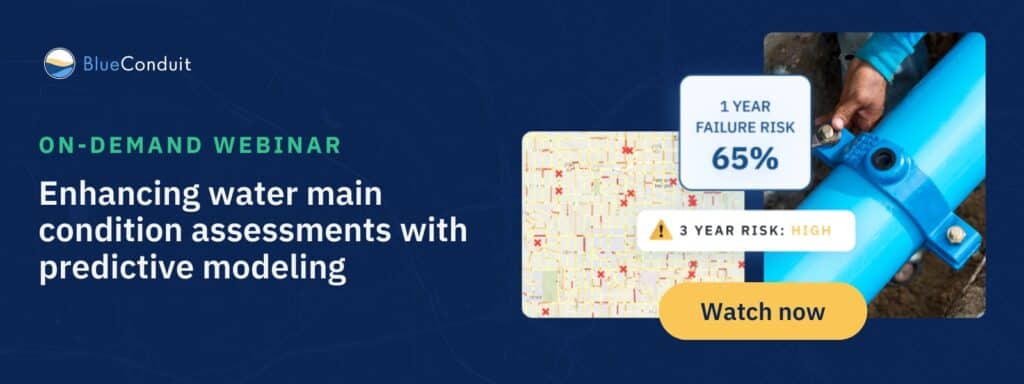Large diameter water mains are often treated as high priority when it comes to proactive maintenance because of the high consequence of failure (CoF). But a failure to also identify small diameter mains for proactive maintenance and replacement misses a key opportunity for water systems to get ahead of water main risk and build customer confidence.
Let’s investigate why proactive maintenance and replacement matters for small diameter water mains and see how BlueConduit partner Mobile Area Water and Sewer System (MAWSS) is tackling their small diameter mains.
Risk for small diameter water mains is often underestimated
In a standard risk assessment for water mains, risk is calculated by multiplying the likelihood of failure times the criticality, defined as the impact, of that failure. Water system operators often treat large diameter water mains, including transmission mains, as higher risk (even without doing a full risk assessment) because of their criticality in the system – in other words, regardless of likelihood of failure, large diameter mains are often difficult and expensive to repair/replace and, in some cases, provide service to larger populations.
Criticality is important (some might even call it critical 🙂) and shouldn’t be ignored. However, a broader look at criticality shows that many smaller diameter mains also have high criticality including impact on an arterial street, proximity to rail or freeway crossing, and service to a critical customer such as a hospital or dialysis center.
Small reactive costs can add up quickly
Even for those small diameter mains where criticality is low, there are economic and social costs associated with a water main failure, from reactive maintenance to community disruption. And those costs can add up quickly.
In Mobile, Alabama, 80% of water mains in the top 1% likely to fail in the next 6 months are small diameter mains (10” or less). This is hundreds of water mains, nearly all of which have broken previously, that are likely to fail in the very near future. If only 10% of these mains failed in this timeframe, Mobile is still looking at 2+ small diameter main failures per week.
The cost of reacting to small diameter main failures can limit the ability to invest in strategic priorities
The need to continually respond to failures is expensive; there’s the cost of the repair, the repair crew (including, often, overtime or off-hours surcharges), the community disruption, and more. In serious breaks, you also need to contend with boil water advisories, press coverage, and community frustration.
Beyond expensive, this is distracting. If you are always focused on reacting to urgent needs, it is difficult to ever get to the work that’s really important for your system.
Russell Lomax, MAWSS Water & Sewer Operations Manager, explained how this challenge shows up in Mobile, Alabama:
“With a break rate of 0.595 per/mile in 2023, [and most breaks occurring] on 6 & 8 inch lines, it isn’t easy to prioritize pipe replacement. MAWSS’s primary challenge, like many other utilities, is capital. We simply don’t have enough money, so we have to prioritize the projects.”
The Mobile Area Water and Sewer System (MAWSS) is getting ahead of small diameter water main failures with BlueConduit’s Water Mains Prediction solution.
“BlueConduit’s predictive modeling approach gives us a start in creating a more proactive and defensible water line replacement program,” says Lomax. With water main data enriched with weather, parcel, soil and other relevant data, BlueConduit provides likelihood of failure predictions and criticality support for every water main. Combined with an easy-to-use platform, BlueConduit puts Mobile in charge of their own data, helping them identify data trends, risks, and opportunities for proactive management.
You can read more about Mobile’s experience with BlueConduit here. If you want to dive a little deeper, check out our on-demand webinar, which features Russell Lomax along with BlueConduit experts.






